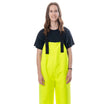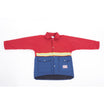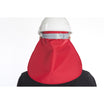Importance of Rain Gear for Construction Workers
Protective clothing for construction workers is undoubtedly crucial. Especially when considering outdoor environments, rain gear becomes an essential set of protective wear not to be overlooked. Not only does it keep workers dry during rainy spells, but it also increases visibility in hazy weather conditions.
Protection and Durability
Construction workers require robust and protective rain gear that fulfills their specific needs. Let's break down why rain gear is so vital:
- Guard against Rain: It provides an impermeable barrier between the worker and precipitation, shielding them from potential health risks associated with being wet and cold for extended periods.
- Work Efficiency: It ensures that work can continue in rainy weather without much discomfort to the workers, thereby reducing work disruptions.
- Durability: Ideal rain gear for construction workers is sturdy, resistant to wear and tear, and able to endure the harsh environmental conditions often encountered on construction sites.
- Visibility: Many types of rain gear come with reflective accents that increase workers' visibility, making them easily noticeable against foggy or rainy backgrounds, enhancing safety.
Suitable Brands for Waterproof Construction Gear
Now that we have established why rain gear for construction workers is important, let's look into some brands known in the industry for their waterproof construction gear options:
- Dickies and Carhartt: These established workwear brands offer a wide range of durable, waterproof products. Carhartt is recognized for producing sturdy, waterproof PVC rain gear renowned in the hard labor industries.
- Custom LeatherCraft and Dutch Harbor Gear: Both these brands provide industrial strength rainwear that will last in the most grueling conditions.
- OccuNomix and FROGG TOGGS: Catering to the more specialized needs of construction workers, FROGG TOGGS offers waterproof and breathable rain gear. On the other hand, OccuNomix is recognized for its high-visibility rainwear that increases worker safety.
- Helly Hansen: This brand provides a wide range of rain gear options, including jackets, bibs, and gloves. Renowned for their durability, their gears are an excellent investment.
Choosing the right rain gear brand is paramount for construction workers since it directly impacts their productivity, comfort, and safety while working in challenging weather conditions. Therefore, knowing and trusting in the quality of renowned brands like Carhartt, Dickies, and others is a crucial step towards ensuring safety and optimal job performance irrespective of the weather conditions.
Types of Rain Gear for Construction Workers
Working on construction sites can be difficult, especially in adverse weather conditions. Rain, in particular, can pose several challenges. However, the good news is that a variety of rain gear is available to ensure construction workers stay dry and efficient, no matter the weather. Whether it be jackets, suits, pants, or ponchos, there's something for every need and personal preference.
Options Available
The following are some of the most commonly used types of rain gear in the construction industry:
- Jackets
- Suits
- Pants
- Ponchos
Each type offers its unique set of advantages and suits different needs and working conditions. Choosing the right rain gear depends on various factors, including the nature of the work, the intensity of the rain, and the worker's comfort.
High Visibility Rain Jackets and Safety Rain Coats
High visibility rain jackets and safety rain coats are perfect for those who work in low light and heavy downpours. These clothing items feature reflective elements that enhance the visibility of the wearer, ensuring their safety on the job. They come in a variety of bright colors, most commonly yellow or orange, which allow the wearer to stand out even in the darkest conditions.
Rain-Resistant Workwear
Rain-resistant workwear is specifically designed to protect workers while not hindering their ability to perform tasks. Features often include water repellency, breathability and durability. Many rain-resistant clothing items also come with built-in pockets and utility features that make it easier for workers to carry tools and accessories.
Materials Used
When it comes to materials, most rain gear for construction workers is made from breathable and durable fabrics that can stand up to harsh conditions. These may include:
- Breathable nylon
- Polyester
- Neoprene
- Durable materials like rubber or PVC blends
These materials, known for their water-resistant properties, ensure that the worker stays dry and comfortable throughout the day. They're also typically easy to clean, an added advantage for those working in muddy environments.
Selecting the right rain gear can significantly improve a construction worker's safety and productivity. By considering factors like visibility, rain resistance, and material, workers can ensure they're well-prepared for whatever weather comes their way.
Factors to Consider When Choosing Rain Gear
From summer showers to winter storms, rainfall is a natural element in our everyday life. Whether you're an outdoor worker braving the elements or an urban dweller planning a hiking trip, having the right rain gear is essential. Choosing the optimal rainwear can often be a monotonous task, given the range of products available. Below, we outline key factors to consider when selecting your rain gear, taking into account climate, type of work, visibility, waterproofing, breathability, and your budget.
Climate and Work Type
The environment in which you intend to use the rain gear significantly influences your choice. If you're based in a tropical area with frequent rainfall, then a sturdy, fully waterproof gear might be suitable. Conversely, for areas with light, infrequent rainfall, a water-resistant gear could suffice.
Similarly, the type of work you do impacts your decision. For instance, if you're a construction worker spending substantial time in the open, you need heavy-duty, durable rainwear. On the other hand, light, flexible gear would be more appropriate for a hiker or a cyclist.
Here are key points to remember:
- If you live in a high rainfall area, consider fully waterproof gear.
- Gauge the durability of the gear based on your work type. Heavy-duty for outdoor workers, lightweight and flexible for leisure activities.
Level of Visibility, Waterproofing, and Breathability
Questions one ought to consider include: How well does the gear make me visible in low light, rainy conditions? How effectively will it prevent water penetration? And how well can it 'breathe'? These factors are crucial.
For visibility, bright colors with reflective stripes are ideal for ensuring you are seen in poor light or fog. Some jobs, such as road works or emergency services, might require high visibility rain gear.
When considering waterproofing, remember that no gear is entirely impervious to water, especially under extreme conditions or prolonged exposure. Always consider the level of waterproofing relative to your needs.
Lastly, breathability is essential particularly for those engaged in active jobs or activities. High breathability rain gear allows sweat vapor to escape, keeping you comfortable and dry.
Crucial factors to weigh in:
- Visibility: Opt for bright clothing with reflective elements, especially for jobs requiring high visibility.
- Waterproofing: No gear is fully waterproof, so choose based on the degree necessary for your activity.
- Breathability: For active or sweat-inducing jobs, gear with high breathability is suggested.
Budget
While you might be tempted to splurge on high-end rain gear, it's essential to consider its cost-effectiveness. Cheaper gear might not last as long, leading to frequent replacements, and consequently, higher costs in the long run. On the other hand, spending significantly on gear only used occasionally might not justify its price. It is about finding a balance based on your usage and requirements.
Remember:
- Cheaper gear might not always be cost-effective in the long run.
- High-end gear might not be justified for occasional use.
- Striking a balance based on usage and demands is key.
In the end, choosing rain gear is a personalized process, revolving around your specific needs and preferences. Evaluating these factors will guide you towards making an informed decision, ensuring you remain dry and protected in all conditions.
Recommended Rain Gear Brands for Construction Workers
As winter approaches and project timelines tighten, it becomes increasingly evident that construction workers need more than just hard hats and work boots to face the elements. Weather can significantly impact productivity, and one of the most problematic conditions to work in is rain. It's not just about discomfort; wearing improper rain gear can result in health problems and decreased efficiency. This is why it's essential to invest in high-quality rain gear designed to meet the unique needs of construction workers. Here, we will discuss three top rain gear brands that are gaining popularity in the construction industry, including Carhartt, Mountain Hardwear, and Helly Hansen.
Carhartt
Carhartt is a brand that needs little introduction in the world of rugged workwear. They've been around since 1889, continuously producing durable and dependable gear for labor-intensive jobs. However, what sets Carhartt apart is their innovative rain gear made with cutting-edge waterproof technology. Carhartt's rainwear provides superior protection against the elements, enabling construction workers to perform their tasks more comfortably and safely. Here are some reasons why Carhartt is a preferred choice among builders:
- Their products are often crafted from heavyweight, water-repellent fabric.
- They offer breathability, a must-have for physically demanding jobs.
- They provide a wide range of products, from heavy-duty rain jackets to waterproof work pants.
Mountain Hardwear
Next on the list is Mountain Hardwear, a company synonymous with high-endurance outdoor gear. Mountain Hardwear's cutting-edge technology is designed to shield wearers from harsh conditions, making it an apt choice for construction workers. Here's why this brand stands out:
- Their rain gear utilizes Dry.Q technology, providing exceptional breathability and water resistance.
- They offer a great fit without sacrificing mobility, essential for workers on the move.
- Their garments come with reinforced, abrasion-resistant areas, making them extra durable.
Helly Hansen
Finally, we have Helly Hansen, a company that began its journey creating waterproof clothing for seafarers. Now, they're a globally recognized brand providing high-quality rain gear for various industries, including construction. Here's why construction workers should consider Helly Hansen:
- Their gear uses Helly Tech® Protection, ensuring the product is waterproof, windproof, and breathable.
- They offer designs that allow for easy layering, promoting warmth and flexibility.
- Their products are recognized for their longer shelf life, attributed to the brand’s high-quality materials and manufacturing process.
Choosing high-quality rain gear is crucial to ensure safety, enhance performance, and maintain health while increasing productivity. Moreover, brands like Carhartt, Mountain Hardwear, and Helly Hansen provide the quality, durability, and innovation that construction workers require to conquer tasks in any weather condition. So, let it rain; with such quality gear, you're more than ready to face the elements!
Benefits of Proper Rain Gear for Construction Workers
Just as a warrior wouldn't go to battle without his shield, a construction worker mustn't step onto a job site without proper rain gear. It's not just about avoiding a soaking wet day at work; it's about protection, safety, comfort, and improved mobility. You'll realize that with the right rain gear, overcast skies won't overshadow your productivity.
Protection from Elements
Rain, wind, cold — construction sites can subject workers to a mix of weather onslaughts. But here's the good news: quality rain gear can serve as your weatherproof shield.
- Effective Rainfall Shield - A sturdy raincoat and pair of rain pants offer excellent protection against soaking showers. Think of them as your first line of defense when the skies open up.
- Wind and Cold Resistance - Gusty winds can be just as challenging as rainfall. Quality rain gear provides an extra barrier against chilly gusts, keeping you warm amidst the wind. Add a thermal layer underneath, and even freezing temperatures won't be a match.
- UV Protection - Some might overlook this, but exposure to UV rays can be harmful even on cloudy days. Top-tier rain gear often has UV protection, serving as your personal shady oasis on sunny or overcast days.
Safety and Comfort
On a construction site, safety must always come first. Here's how the right rain gear helps keep you safe and comfortable:
- Visibility - Rainy conditions can drastically reduce visibility on a job site. However, rain gear with reflective material can make workers more visible to machine operators or passing vehicles, reducing the risk of accidents.
- Waterproof Boots - Construction sites may turn into muddy pools during heavy rain. Waterproof boots not only keep your feet dry but also offer protection against slips or falls.
- Breathability - It's essential to stay dry from both the outside rain and your own sweat. Look for gear made with breathable fabrics that allow sweat evaporation while keeping the rain out.
Mobility on the Job Site
Rain gear isn’t just about protection; it mustn't hinder your movements either. Look for gear that offers:
- Flexibility - You need clothes that move with you. Your rain gear should allow easy movement, despite its toughness.
- Layering - Consider gear that can be adjusted or layered depending on the weather. This will allow you to adapt to any climatic conditions at the job site.
While investing in high-quality rain gear might seem like an added expense, think of it as an investment in your safety, comfort, and productivity. When you're well-protected against the elements, you'll be better equipped to focus on the task at hand, rain or shine!
Conclusion
No matter your role on the construction site, proper rain gear isn't just a nice-to-have, it's essential to job performance and safety. When investing in rain gear, be sure to consider factors like climate, visibility, the nature of your work, and of course, the level of protection the gear provides. While there are several excellent brands on the market like Carhartt, Mountain Hardwear, and Helly Hansen, it's important to find the gear that's right for your individual needs.
Brands like Hurricane Raingear are worth considering, with their 100% waterproof and rip-resistant gear that delivers comfort without compromising visibility or flexibility. Protection from the elements, safety and comfort, along with mobility on the job site, all come down to the quality of your rain gear. Take your time to find that perfect fit, tailor-made to weather any storm. After all, your rain gear is just as crucial as any tool in your construction toolkit.
Frequently Asked Questions
-
What are the essential features to look for in rain gear for construction workers?
Essential features to look for in rain gear for construction workers include waterproof or water-resistant material, sealed seams, durable construction, reflective elements for visibility, adjustable cuffs and hems, and multiple pockets for storing tools and equipment.
-
Are there any specific safety standards or certifications that rain gear for construction workers should meet?
Yes, rain gear for construction workers should meet safety standards such as ANSI/ISEA 107 for hi-vis garments and ASTM F2733 for rain gear. Look for products with these certifications to ensure they meet the necessary safety requirements.
-
Should I choose a one-piece or two-piece rain gear for construction work?
The choice between a one-piece or two-piece rain gear depends on personal preference and the specific job requirements. One-piece rain gear offers better overall protection and may be preferred in heavy rain, while two-piece rain gear provides more flexibility and can be easily layered.
-
How do I determine the right size for rain gear?
To determine the right size for rain gear, refer to the manufacturer's sizing chart and measure your chest, waist, and inseam. Consider allowing some extra room for layering if needed. It's important to choose appropriate sizing to ensure comfort and unrestricted movement.
-
How should I clean and maintain my rain gear?
Follow the manufacturer's instructions for cleaning and maintenance of your rain gear. In general, it's recommended to machine wash with mild detergent, avoid using fabric softeners or bleach, line dry or tumble dry on low heat, and periodically reapply DWR (durable water repellent) treatment to maintain the water-resistance of the gear.





















Leave a comment
This site is protected by hCaptcha and the hCaptcha Privacy Policy and Terms of Service apply.